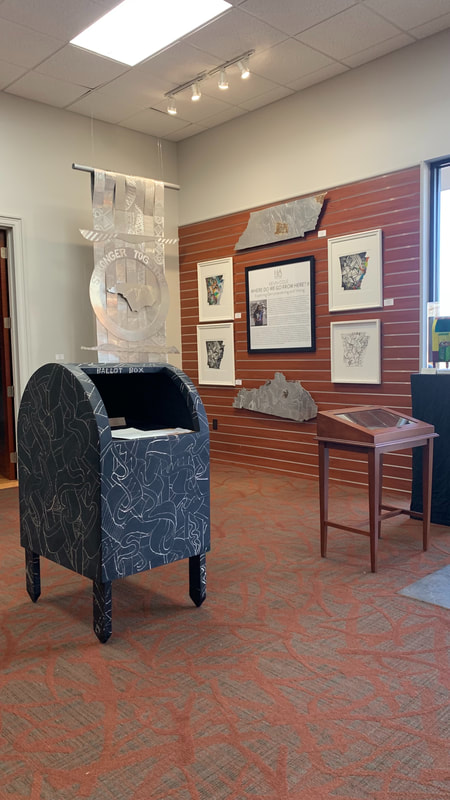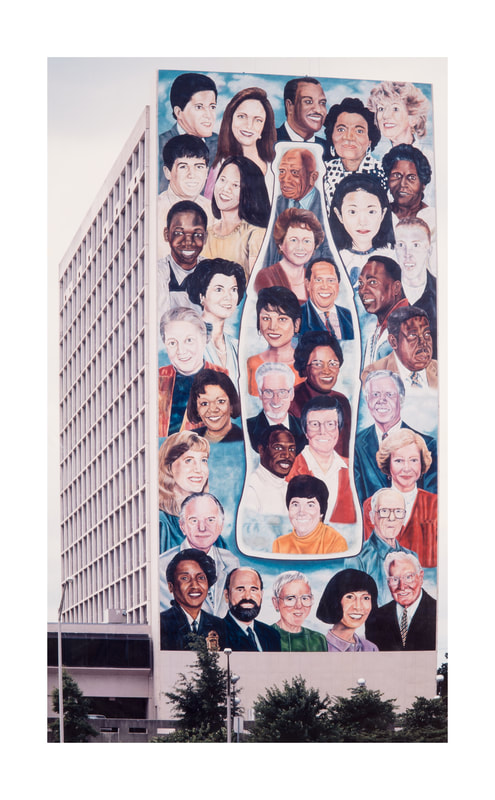PEOPLE // Artist
Kevin Cole - Artistic Protest
by Janee Miller - 06.01.2023
Arkansas native, Kevin Cole, uses neckties and scarf shapes as a motif, depicting the relationship between sight, sound, and color. He uses various mediums, including wood, paper, and aluminum, creating concepts and ideas that are inspired by music rooted in African American heritage. His artwork has been featured in more than 490 exhibitions and 4000 public, private, and corporate collections throughout the United States and abroad. Mr. Cole is affiliated with multiple art galleries, one being the Hearne Fine Arts in Little Rock, where his thought-provoking "Where Do We Go From Here? II: Exploring Gerrymandering and Voting” exhibit was available for viewing. His collections have been locally showcased in art depositories, including the Arkansas Museum of Fine Arts, the Arkansas Art Center, and the William Jefferson Clinton Library.
Mr. Cole was born and raised in the city of Pine Bluff. He comes from a large family, having five sisters and one brother. Both his mother and father served the citizens of their city through their professions. His mother worked in the Pine Bluff School District as a Cafeteria Manager, while his father worked as a caretaker of the graveyards at Ralph Robinson Funeral Home. At the age of eleven, Mr. Cole was first influenced to create art by his mother. When Mr. Cole had a bad day, his mother would ask him to make her a picture. She influenced him to use art as a means of communication, which would lead him down the successful path of being both an artist and educator.
Mr. Cole received his B.S. in Art Education from the University of Arkansas at Pine Bluff, his M.A. in Art Education from the University of Illinois at Urbana, and his M.F.A. from Northern Illinois University. At the age of nineteen, Mr. Cole participated in his first professional art exhibition. Since his start, he has received 28 grants and fellowships, over 67 art awards, and 51 teaching awards.
Mr. Cole was born and raised in the city of Pine Bluff. He comes from a large family, having five sisters and one brother. Both his mother and father served the citizens of their city through their professions. His mother worked in the Pine Bluff School District as a Cafeteria Manager, while his father worked as a caretaker of the graveyards at Ralph Robinson Funeral Home. At the age of eleven, Mr. Cole was first influenced to create art by his mother. When Mr. Cole had a bad day, his mother would ask him to make her a picture. She influenced him to use art as a means of communication, which would lead him down the successful path of being both an artist and educator.
Mr. Cole received his B.S. in Art Education from the University of Arkansas at Pine Bluff, his M.A. in Art Education from the University of Illinois at Urbana, and his M.F.A. from Northern Illinois University. At the age of nineteen, Mr. Cole participated in his first professional art exhibition. Since his start, he has received 28 grants and fellowships, over 67 art awards, and 51 teaching awards.
“My work is a colorful reminder of promises still unkept, imperialism still institutionalized, and stealth deceit that has stolen the dreams and birthrights of twenty generations of a once proud people.”
Q&a
|
What is your fondest memory of your creativity?
Creating a mural for the 1996 Olympics. The process and the way it was done – I never touched the wall, which was one of the most interesting projects at any of the Olympics. I created it on a contact paper, and there was somebody else installing it. The other unique part of this project is that I was bending wood. I think I am one of the few artists in the country that bends wood. Where has your art taken you in a literal sense? The art has basically taken me all over the world. How do you stay connected to your community while progressing in your career as an artist? I taught for 32 years. I taught middle school for a while, and then I taught high school and college. I’ve always maintained a studio, in which, I’ve always hired some of my former students. Right now, I have three assistants. One of my assistants – he’s been with me since he was in the seventh grade, and he is forty-six years old now. What are you most proud of in terms of your career? I’m proud of my career as an educator. As many awards as I have won for my art, I’ve won as an educator. I was a “Teacher of the Year” at three different schools. I was the first African American to win both the Georgia Secondary Art Educator of the Year Award and the National Art Educator of the Year Award of the Southeastern Region. I am proud of being able to maintain the status of being a professional artist and an award-winning educator. How has the art world changed since you entered? It has changed a great deal in terms of technology. You can email images now. You can create images on the computer. There are a lot of things that have changed. Even the way people buy art and create art. What do you like most about being an artist? The freedom of expressing yourself. Share the most challenging part about being an artist. For most artists, it’s finding the support in terms of people buying their work and getting support in terms of adding collectors. I haven’t really had that much of a problem with that. I’ve been truly blessed. I have several NBA basketball players, including Michael Jordan, as collectors. Darryl Walker, who is in Little Rock, he’s one of my biggest collectors. Brenda and Larry Thompson, Kerry and Betty Davis, and Greg Head, Senior Partner and Chief Storyteller of SmartThink Marketing Group, Inc. in Duluth, Georgia, have also been supporters of my work. How did mentorship play a role in the advancement of your career, if at all? I was blessed. There were four men at the University of Arkansas at Pine Bluff that changed my life – the late John Howard, who was the Chairman of the Art Department, Henry Linton, Terrance Corbin, and Earnest Davidson. I ended up meeting Sam Gilliam, an internationally known artist, who took me under his wings and guided me. The mentorship that I had allowed me to not make a lot of the mistakes that other artists made. |
Do you have any positive advice that you would like to share with others considering a career as an artist?
The number one thing is you don’t get into art to make money. You get into art because you are called just like a person is called to be a minister. I didn’t choose art, art chose me. A lot of artists worry about money, but money comes, and money goes. If you approach art as doing something you really like, then it’s not a job. And I think that if you stick with it long enough, the monetary things will come, and the notoriety will come. How important is artistry to Black people and the Black community? The visual arts are very important. The visual arts can make a statement that is different from music. Visual art is a picture worth a thousand words. What role does politics play in your work? The show at Hearne Fine Arts was about Gerrymandering and voting. The concept behind the “Ballot Box” collection was inspired by a book I was reading by Ron Walters, who was a Political Strategist at Howard University, entitled, Freedom is Not Enough. His wife gave me the book to read, and I found out that he was my fraternity brother of Kappa Alpha Psi Inc. The more I read about him, the more I kept going back to legislation and voting. I asked my friends to ask their parents and grandparents what were some of the struggles they experienced in terms of poll taxes in the South. And a lot of them were in their 80s and 90s that refused to be interviewed. But they talked about their experience with voting, where they were asked stupid questions like, “How many black-eyed peas in a bag? How many bubbles are in a bar of soap?” How important/needed is Black representation in artistry? It is very important. The visual arts are something that we’ve been involved in for a while now. African American Artists are just now being noticed for their achievements. Now, you see a lot of older African American artists being recognized. How has being a Black person in your profession been? Being an African American artist, like being an African American male, you walk in and out of two worlds, one black and one white. The higher you get, in terms of collectors, the less of us you see. The importance for me, which I learned from my professors at UAPB, was to not just be an artist but share your knowledge. It’s like that old African Proverb, “Each one, teach one.” What do you wish people knew about being an artist? How difficult it is. People think that because you are an abstract artist, you just get up and throw paint on something. A lot of art comes with a lot of research and trying to get your ideas together. The lack of support also makes it difficult for a lot of the young artists. What legacy do you want to leave? When I was doing the mural for the Olympics, I did portraits of people who were like the “unsung heroes” of Georgia. Before I painted their portraits, I would interview them. When I interviewed the late Maynard Jackson, the first African American mayor of Atlanta, I asked him what he wanted his legacy to be. He said something that struck me that I’ve been using ever since. He said that he lived by a verse from a poem by Alice Walker – “When I die would it matter if I was ever born?” It’s always about moving forward and making a difference for others and not necessarily yourself. |







